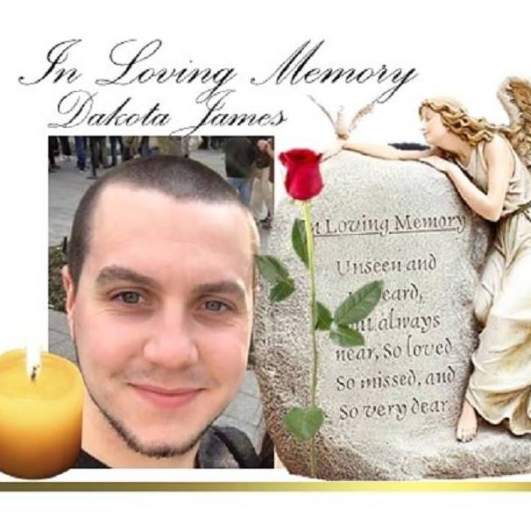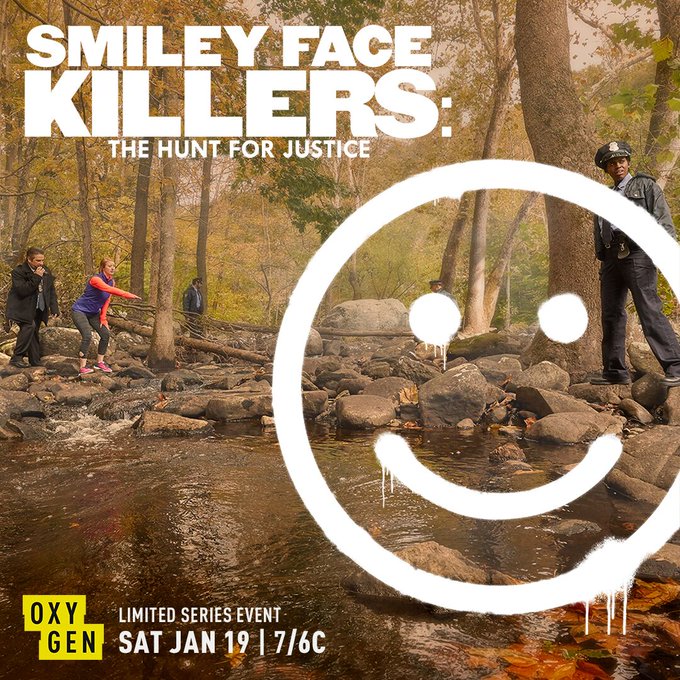
Facebook Kevin Gannon
Kevin Gannon is a retired New York Police detective and homicide investigator whose Smiley Face killers theory is the subject of a new Oxygen Channel series.
Gannon, and a group of other investigators, believe the deaths of young men who were found deceased in rivers and lakes throughout the United States may really be the work of a gang of serial killers. For at least a decade, Gannon has argued that some of the dozens of deaths of young men – from Wisconsin to Pennsylvania to Minnesota – may not be accidents. However, authorities in local jurisdictions and, years ago, the FBI, have attributed the deaths to alcohol, saying they have not found evidence of a serial killer smiley face gang. If Gannon and his team of investigators have specific names to put to suspects, they haven’t revealed them publicly.
The Oxygen channel series about the theory is called Smiley Face Killers: The Hunt For Justice. Heavy interviewed Gannon in depth about the alleged gang. You can read that interview here.
The deaths, which have occurred since at least 1997, involve similar victimology. The victims are young, athletic, handsome men, typically in their 20s and typically Caucasian, who vanish after nights out in bars with friends, only to turn up deceased in rivers or lakes. In most cases, the deaths were either ruled accidental or undetermined. The investigators claim the killers left scrawled smiley faces at some of the scenes.
Here’s what you need to know:
1. Gannon Says a Dangerous ‘Domestic Terrorist’ Group Is Involved in the Deaths
In 2008, Gannon took his theory about a smiley face serial killer gang public, and, with the launch of the Oxygen series, he’s done so again.
“To me, this is one of the most dangerous domestic terrorist groups in the United States and somebody needs to pay attention to them,” Gannon said to the Daily Beast. “The level of sophistication of the group is a lot greater than we’d imagined. Now we know they communicate with each other on the dark web. We know there’s surveillance and counter-surveillance.”
The Oxygen series’ first episode will premiere on January 19, 2019 at 7 p.m. ET/PT.

FacebookDakota James
The Oxygen series has chosen six cases to feature out of a list of many dozens. The deaths featured on the Oxygen channel show are those of Dakota James of Pennsylvania; of Tommy Booth, also in Pennsylvania; of Lucas Homan in Wisconsin; of Todd Geib in Michigan; of William Hurley in Massachusetts; and of Brian Welzien in Illinois. Dakota James is the subject of episode one. You can see videos and more details relating to that case here on the Oxygen Channel’s website.
The death of Dakota James follows the pattern of many of these deaths. Age 23, he disappeared around 11:30 p.m. on January 25, 2017 in Pittsburgh, Pennsylvania.
“James was walking back to his apartment after a night out drinking with friends and co-workers. He never made it home. The last known sighting of the Duquesne University graduate student was caught on a surveillance camera in the downtown area,” reports Oxygen. “The footage captured James entering a dark alley, and that was the last time he was seen alive.”
The following morning, his family filed a missing person’s report when he didn’t show up for work. “James’ parents later hired a private investigator who organized a massive citywide search, which led to the discovery of James’ body in the Ohio River on March 6, 2017, 40 days after he had disappeared,” the channel reports. “The Pittsburgh police theorized James fell into the river while crossing a bridge near the city center and drowned. They believed his body traveled for almost 10 miles and even went through a dam before its discovery.”
However, claims Oxygen: “James’ body, however, had almost no visible damage, which was highly suspicious because it had traveled through heavily trafficked river. A smiley face was found spray painted on an underpass near where James’ body
On the Oxygen show, famed pathologist Cyril Wecht said that marks on James’ neck “strongly suggestive of and entirely consistent with a ligature having been applied around the neck. This death may have been due to ligature strangulation.”
The other deaths are similar. Tommy Booth “disappeared on January 19, 2008 from a bar in Woodlyn, Pennsylvania. That night, he had been celebrating a friend’s 21st birthday with a group of friends. Surveillance footage captured Booth entering the bar where the celebration took place, but there is no video evidence of him leaving,” says Oxygen. “About two weeks after he went missing, Booth’s body was found facedown in a creek behind the bar.”
Lucas Homan was found dead in La Crosse, Wisconsin, where there has been a cluster of deaths. “On September 29, 2006, 21-year-old Lucas Homan vanished from La Crosse, Wisconsin,” says Oxygen. “The day of his disappearance, Homan had been celebrating Oktoberfest with his friends. After a night of barhopping, Homan headed home at around 10 p.m. with a friend. Homan and his friend somehow got separated during their walk home, and his friend ended up at the ER detox with a head injury after being picked up by police. He told investigators he could not remember anything that happened that night.” Homan was found near the Mississippi River and his death was ruled an accidental drowning.
Todd Geib, 22, vanished on June 12, 2005, “at a bonfire party in an orchard close to his home in Casnovia, Michigan,” reports Oxygen, which says he made a cell phone call saying he was in a field. He was “found three weeks later in a lake that had previously been searched. His death was ruled an undetermined drowning,” reports Oxygen.
William Hurley, a Navy veteran, was 24 when he “went missing after leaving a Bruins hockey game in Boston, Massachusetts,” reports Oxygen. His body was found in the Charles River, and authorities ruled the cause undetermined drowning.
Brian Welzien disappeared on January 1, 2000, reports Oxygen, which describes him as a “Northern Illinois University junior” who “went missing from Chicago, Illinois, after a night of celebrating Y2K with his friends.” Seventy-seven days later, reports Oxygen, his body :washed ashore on a beach in Gary, Indiana.”
2. The Drowning Deaths Have Occurred Since 1997 & a Death in New York First Interested Gannon in the Pattern
The death of Patrick McNeill, a New York man, sparked Gannon’s interest in the cases. According to The New York Post, McNeill 20, was a Fordham accounting major. In a 2008 article, The Post said Gannon and the other investigators alleged he “was killed by what they are calling the Smiley Face Gang, which they say has struck in 25 cities in 11 states since 1997.”
The New York Post reports that McNeill “disappeared Feb. 16, 1997, after drinking at a bar on East 92nd Street. His body was found April 7, 1997, near the 69th Street pier in Brooklyn.” Gannon was on the NYPD then, was assigned to the case, and “promised McNeill’s parents he would never give up,” The Post reported.
At the time, the Post quoted Gannon as saying, “They’re psychopaths. They have no remorse. Some of the victims were held for a while until they were put in the water.”
Over the years, Gannon started an investigations agency. “G.D. Investigations was officially established in 2007. However, the spirit of the agency was born back in 1997 when Kevin Gannon promised the parents of a victim of a mysterious drowning in Manhattan that the perpetrator(s) would be caught. The team’s investigative strength grew with the addition of Anthony Duarte & Mike Donovan in 2005. Technical expertise in the areas of crime mapping and criminology were added in 2006 when D. Lee Gilbertson joined the team,” its website says.
In a news release and email, the Oxygen Channel laid out the core of the smiley face serial killer theory.
“Since 1997, hundreds of college-aged men have mysteriously drowned, and their bodies have been found in clusters around the country, and the victims are eerily similar – they’re all athletic, academic achievers,” according to Oxygen.
“In addition, near where many of the bodies are recovered is one distinct mark: graffiti of a smiley face. The series follows an active private investigation spearheaded by retired NYPD Detective Kevin Gannon and his veteran team of investigators as they work with victims’ families and top forensic experts to further investigate.”
The smiley face theory has been around for more than a decade, when the men first staged a media blitz to reveal the theory. In 2008, CNN reported, “Nine of the deceased attended the University of La Crosse, in Wisconsin. Three attended colleges in New York state. In all, the investigators say they’ve connected the bizarre drowning deaths of at least 40 college-age men across the country…The cases spanned 25 cities in 11 states.”
In 2013, ABC 7 in Chicago reported that the number of drownings of young men had reached 200 around the country. Jerry Snyder, a former law enforcement officer who runs a non-profit group called “Find Me,” told ABC 7 that his group had also researched the deaths, saying, “It was time after time, Caucasian male, 18 to 26 years old, good looking, athletic, very intelligent. Every one of these kids were ending up in a river, pond, lake or stream and that just really caught our attention.”
According to ABC 7, “Some investigators said that they think victims were rendered helpless either by injection or a spiked drink but that medical examiners and coroners don’t routinely test for those drugs.”
Oxygen calls the drowning deaths the “country’s most notorious string of mysterious, accidental drownings” and alleges that they may not be accidents, “but homicides; and they could all be connected to a larger theory of The Smiley Face Killers.”
The men vanished after “a night out drinking with friends,” reports Oxygen. Along with Gannon, the investigators include Anthony Duarte, Mike “Mikey” Donovan and D. Lee “Doc” Gilbertson, “who have dedicated the past 12 years of their retirement to finding justice for these cases.”
Oxygen acknowledges that “all of the drownings have been individually classified as accidental or undetermined and have not been investigated as possibly related crimes. There are grieving families of these young men who are convinced that there is something more sinister at play, and desperately search for answers with Gannon and the team. Their goal is to gather enough evidence to convince local authorities to reclassify and investigate these deaths as homicides. Only then can the team attempt to establish a possible connection between these deaths to further their theory that the young men are victims of a calculated group known as The Smiley Face Killers.”
The FBI looked at the cases in 2008 and released a statement that there was no evidence to support the smiley face serial killer theory. Instead, wrote the FBI, the cases appeared to be “alcohol-related drownings.” That statement was released before some, but not all, of the cases featured in the Oxygen series.
The FBI’s statement read:
Over the past several years, law enforcement and the FBI have received information about young, college-aged men who were found deceased in rivers in the Midwest. The FBI has reviewed the information about the victims provided by two retired police detectives, who have dubbed these incidents the ‘Smiley Face Murders,’ and interviewed an individual who provided information to the detectives. To date, we have not developed any evidence to support links between these tragic deaths or any evidence substantiating the theory that these deaths are the work of a serial killer or killers. The vast majority of these instances appear to be alcohol-related drownings. The FBI will continue to work with the local police in the affected areas to provide support as requested.
The statement was attributed to supervisory Special Agent Richard J. Kolko, Washington, D.C.
3. Gannon Spent 20 Years on the NYPD & Was in Charge of a Bronx Homicide Task Force
Gannon and St. Cloud University Professor Lee Gilbertson are authors of a book called Case Studies in Drowning Forensics. The book explores the drowning deaths in detail.
The book blurb on Amazon reads, “When a corpse is found in a body of water, authorities generally presume that the manner of death was either an accident or a suicide. They do not treat the recovery site as a potential crime scene or homicide, so many cases remain unsolved. Case Studies in Drowning Forensics investigates the cases of 13 bodies recovered from water in similar circumstances and one survivor. The product of intensive field investigation and archival research, this is the first book that presents and explains forensic autopsy evidence associated with the ‘Smiley Face’ murders.”
You can hear Gannon discuss the theory here.
The blurb provides a description of Gannon’s resume. He spent years investigating homicides for the New York Police Department.
Kevin Gannon retired as a Sergeant in the Detective Bureau from the New York City Police Department after 20 years of service, which included more than 14 years as a supervisor. He has diversified training and experience in personal and physical security, investigation and surveillance, and disaster response. His background includes leadership positions responsible for the personal protection of numerous international dignitaries and personalities. He was an NYPD representative on Giuliani’s 1997 ‘Operation ICE’ (Interagency Chemical Exercise) task force, which planned and coordinated for an emergency response to a major chemical disaster in lower Manhattan. Participation included Department of Defense training related to biological and chemical warfare. Gannon has supervised plainclothes personnel in anti-crime, narcotics and robbery units, and was second in charge of the NYPD’s Missing Persons Squad. He was in charge of the Bronx Homicide Task Force (Nightwatch) from 1999 until his retirement in 2001. Gannon has made over 1,000 felony apprehensions for crimes involving narcotics, burglaries, robberies, and homicides. During his distinguished career, Gannon was awarded almost 100 medals for bravery. He was the most decorated member of the Special Investigation Division of the Detective Bureau and one of the most highly decorated Sergeants in the NYPD before his retirement. He was a two-time recipient of the Medal of Valor (1994 & 1996) from Mayor Giuliani for heroism in the line of duty. For his investigative work on gang crime, Gannon received the Frederic Milton Thrasher Award (2008) from the National Gang Crime Research Center.
It provides this bio background on Gilbertson:
D. Lee Gilbertson holds a doctorate (Ph.D.) in Sociology (2002; with a concentration in gangs and substance abuse) and a Master of Science in Criminal Justice (1996; focusing on criminology and victimology). His background includes 16 years of exemplary military service (infantry and signals intelligence) from 1976 to 1992. In addition to his regular duties, he also received training in and served as the unit Alcohol and Drug Coordination Officer (responsible for substance abuse prevention training and supervising urinalysis collections), and as the unit Nuclear, Biological, and Chemical Warfare Defense Officer. He currently teaches at Saint Cloud State University and has consulted with law enforcement and provided training in the areas of forensic victimology, crime analysis, and gangs. He has studied gangs, militias, and extremist groups since 1995 and is a certified gang specialist. Gilbertson has presented and taught at numerous national and international conferences and academic institutions, and is a European polyglot. He is a staff member of the National Gang Crime Research Center and has participated in every iteration of its International Gang Specialist Training Conference. Gilbertson is a three-time recipient of the Frederic Milton Thrasher Award (2002, 2005, and 2008), and is an Executive Editor for the Journal of Gang Research.
One case that stands out but isn’t featured on the Oxygen series is that of Chris Jenkins, a Burlington, Wisconsin man who was found in the Mississippi River after a night out drinking in Minneapolis.
As far back as 2002, The New York Times was reporting: “Young People Are Missing; Authorities Are Baffled.” That article reported that Christopher Jenkins was one of four young men who drowned in rivers in Minnesota and Wisconsin. The article described Jenkins as “a senior and co-captain and goalie of the lacrosse team at the University of Minnesota. Dressed as an American Indian, he had gone to a Halloween party at the Lone Tree Bar and Grill.”
What’s interesting to a lot of people is that, for years, police in the Jenkins’ case would not say that Jenkins died from foul play – just like other drownings throughout the country. However, in 2006, they did a shocking about-face.
In 2006, The Associated Press reported that police announced Jenkins “was thrown off a bridge in downtown Minneapolis …they apologized for first suspecting his death was a suicide or accident.” The cause of death had initially been listed as undetermined. However, although they had a suspect in mind at the time, no one was ever charged. “Chris’ death at this time is not linked to any of these other deaths, especially there’s quite a few involving college students,” Sgt. Pete Jackson told the AP at that time. “I have been contacted today quite a bit by other agencies from around the Midwest. We’ve had several deaths involving college students. But there’s nothing at this time to connect Chris’ death between the others.”
However, authorities’ reclassification of the Jenkins’ death as a homicide has helped fuel the serial killer theory. The case was featured on Investigation Discovery Channel.
A 2008 article in Milwaukee Magazine (written by this author) dug deeper into the theory. At that time, Gannon and his team had launched their media blitz to gain currency for the theory after deaths occurred in Wisconsin and Minnesota, gathering heavy news coverage in those states.
Reported Milwaukee Magazine: “After three months of research into the case, Milwaukee Magazine has learned a gang …claims involvement in the deaths of some of these men.” You can read the full Milwaukee Magazine report here.
To this day, no charges have ever been filed in the Jenkins’ case, and Jenkins’ mother said in 2018 that she hadn’t had contact with Minneapolis police about it since 2010.
4. Gannon’s Father Was a Cop & He Says He Pays Meticulous Attention to Detail
Gannon told Crime and Investigation that his “meticulous attention to detail” makes him a good investigator.
“My meticulous attention to detail, as well as my ability to communicate with all types of people and to be able to put them at ease. The ability to empathize with both the victims and perpetrators has allowed me to secure information from both parties, which has been instrumental in helping to solve numerous cases,” he said.
He told the site that his father was also a law enforcement officer, saying that his dad was his inspiration: “My father, who was the greatest detective/police officer ever! His work ethic along with his respect and dignity for all people continues to inspire me today. His idea of police work being more about service to the community than just about arrests, medals, and numbers, is something I constantly try to remember and emulate.”
St. Cloud State University Professor Lee Gilbertson, who is an expert in spatial analysis, found patterns in river deaths throughout the country, including the fact that, at that time, “94 percent of the deaths occurred within 100 miles of Interstate 94,” Milwaukee Magazine reported. “The men are generally fit, good-looking, Caucasian, in their 20s, and separated from friends after nights in bars or parties. A few vanished after leaving dorms. Most are drunk. Most turn up dead in rivers or lakes, and with no obvious trauma.” The team told the news media back then that they had found 22 smiley faces.
“The smiley faces are rudimentary, mostly drawn in white paint. Some have three-pointed crowns. Nine have horns. A red smiley face was reportedly found in a drainage ditch in the March 2007 death of Abel Bolanos, 19, a college student found in an Iowa lake. It reads: ‘Evil Happy Smiley Face Man.’ The detectives claim they have 12 pieces of matching evidence, including nicknames left at scenes,” the magazine reported.
Gilbertson told Fox 9 after news broke about the Oxygen series: “The goal of the series is to try and get justice for these families. Whether or not they ever find out who the killers are remains to be seen.” The station reported that Gilbertson’s involvement in the theory dates to 2006, when he studied it with a group of graduate students.
5. Gannon Has Weathered Controversy Along the Way & Is a Cancer Survivor
Along the way, as the team continues to investigate deaths, Gannon has run into controversy. He “was investigated in the sexual assault of a 19-year-old University of St. Thomas student last spring during the search for a missing St. Thomas freshman,” reported Twin Cities.com in 2010. However, the newspaper reported that prosecutors closed the case without arrest or charge after “citing insufficient evidence to pursue prosecution.”
According to Daily Beast, he is a cancer survivor.
A lengthy report in the Center for Homicide Research by multiple co-authors studied the smiley face killers theory and debunked it. It says that the first reports by journalists about drowning deaths dated to 1999.
The article asserts: “As many as 22 smiley faces have been identified by investigators, as well as an occasional discovery of the word ‘Sinsiniwa’…Investigators interpret the graffiti as a taunting of the police. The theory of these deaths includes offenders drugging a victim with GHB or a similar drug…abducting the victim…driving the victim around for hours in a van truck, torturing them…and then slipping the body into the water. Detectives allege the motive for the dumping of remains into the water is to wash away evidence…”
The article says that “in the Jenkins case, a correctional inmate is said to have confessed guilty for the killing to a cellmate.”
The article notes that there was a “happy face” killer (unrelated) in the past; in 1992, serial killer Keith Jesperson of Wyoming “sent anonymous letters to news reporters signed with a hand-drawn smiley.” His victims were female but didn’t drown.
The researchers identified 40 deaths and added more cases to it, eventually totaling 150. They identified various problems with the smiley face serial killer theory, including:
-Time-order issues. They said there’s no proof when the smiley faces were painted and some were found months later or were faded.
-Graffiti is omnipresent. Graffiti is found everywhere, and smiley faces have appeared since 1964 in popular culture.
-The smiley faces don’t match each other and there wasn’t criteria developed to specify “the necessary distance that a smiley face must occur in proximity to a deceased body in order to be counted.”
-No evidence of victim trauma in most cases.
-Homicidal drowning is extremely rare (only 0.2 percent of killings in the U.S.)
-The “general environment of these disappearances are conducive to accidental drowning,” because they occurred “at night and after dark, in an area not far from bars and colleges.”
They also noted that when police in La Crosse stepped up foot patrols, they stopped 50 drunk people from “approaching the river late at night.” They theorized that “many of these drowning cases are likely to have involved aspects of auto-assassination,” which is not suicide but “a style of living with reckless disregard for one’s own life.”
They compared the theory to “monsters of the past,” including Big Foot, Martians and UFOS.
The researchers included a series of photos of graffiti near the Mississippi River to show its prevalence.
The Boston police commissioner also repudiated a serial killer theory when bodies were found in waterways in that city.
A team of volunteers now patrols the area near the Mississippi River in La Crosse, Wisconsin. News 8000 reports they ran across almost 200 intoxicated people in one year alone.
In 2007, Twin Cities.com reported that the La Crosse police “asked the FBI’s National Center for Analysis of Violent Crime to review their investigations,” and both police and the FBI found no serial killer at work (the first La Crosse death was Richard Hlavaty in 1997.) The police chief told Twin Cities.com then that “eight other people who survived falls into water in the area reported no contact with anyone else, and that there had been no reports of suspicious people approaching men in the areas where the victims were last seen.” Authorities attributed the cause to alcohol.





